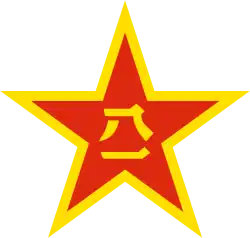Type 59 tank
The Type 59 (Chinese: 59式; pinyin: Wǔ jiǔ shì; industrial designation: WZ-120) main battle tank is a Chinese-produced version of the Soviet T-54A tank, an early model of the ubiquitous T-54/55 series. The first vehicles were produced in 1958 and it was accepted into service in 1959, with serial production beginning in 1963. Over 10,000 of the tanks were produced by the time production ended in 1980 with approximately 5,500 serving with the Chinese armed forces. The tank formed the backbone of the Chinese People's Liberation Army until the early 2000s with an estimated 5,000 of the later Type 59-I and Type 59-II variants in service in 2002.
| Type 59 | |
|---|---|
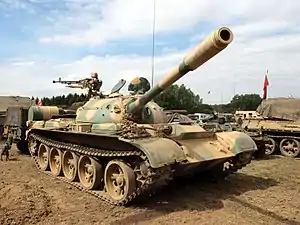 A Type 59 tank at a military exhibit in 2010 | |
| Type | Main battle tank |
| Place of origin | China |
| Service history | |
| In service | 1959–present |
| Wars | |
| Production history | |
| Manufacturer | First Inner Mongolia Machinery Factory, Norinco |
| Produced | 1958–1985 |
| No. built | 10,000 |
| Specifications | |
| Mass | 36 tonnes (35 long tons; 40 short tons)[1] |
| Length | 6.04 metres (19.8 ft) (hull)[1] |
| Width | 3.27 metres (10.7 ft)[1] |
| Height | 2.59 metres (8 ft 6 in)[1] |
| Crew | 4[1] |
| Armor | 20–203 mm[2] |
Main armament | 100 mm rifled gun |
Secondary armament | 2 x Type 59T 7.62 mm coaxial machine gun,[3] Type 54 12.7 mm air-defence machine gun |
| Engine | Model 12150L V-12 liquid-cooled diesel 520 hp (390 kW) |
| Power/weight | 14.44 hp/tonne[1] |
| Suspension | torsion bar |
Operational range | 450 km,[1] 600 km with external tanks |
| Maximum speed | 50 kilometres per hour (31 mph)[1] |
The Type 59 was modified several times during its service. It was also the basis of several later Chinese tank designs including the Type 69 and Type 79 tanks.
Description
The Type 59 is almost identical to the early production Soviet T-54As, but there are some key differences. The Type 59 was not originally fitted with the infrared searchlight or main gun stabilization of the T-54.
The Type 59 has a conventional post-war layout with an engine compartment at the rear and a cast dome-shaped gun turret in the centre of the hull. The hull is welded steel varying in thickness between 99 mm on the front lower glacis to 20 mm on the hull floor. The turret varies in thickness from 39–100 mm.
The driver sits in the front left of the hull, and is provided with a hatch immediately above his seat, which opens to the left. The driver has two pop-up vision blocks which give coverage ahead and slightly to the right when buttoned up. The commander sits in the turret along with the gunner and loader. The commander's hatch is on the turret left, with the gunner sitting forward and below him. The loader sits on the right of the turret and has a hatch above him. The turret has a non-rotating floor, which complicated the crew's operations as they would not rotate with the turret.
The turret mounts a rifled 100 mm Type 59 cannon, for which 34 rounds are typically carried. A Type 59T 7.62 mm machine gun is mounted coaxially with the main gun. A Type 54 12.7 mm anti-aircraft machine gun (the Chinese copy of the Russian 12.7 mm M1938/46 DShKM[3] heavy machine gun) is provided above the gunner's hatch for which 200 rounds are carried. A Type 59T 7.62 mm bow-mounted machine gun is fitted and is fired by the driver through a tiny hole in the center of the front glacis plate. 3,500 rounds of 7.62 mm ammunition are normally carried.
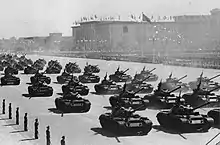
The turret has a powered traverse mechanism that is probably comparable to the T-54 traverse mechanism which can rotate the turret through 360 degrees in 21 seconds. Very early models of the Type 59 gun had manual elevation gear, later replaced with a powered system which allowed the gun to be aimed at between +17 and −4 degrees (the average depression for Western tanks is -10, which allows for better usage of hull-down tactics). Later models added vertical stabilization to make firing on the move practical. An infrared searchlight based night vision system was retrofitted to the tank with infrared periscope for the commander gunner and driver.
The tank is powered by a Model 12150L V-12 liquid-cooled diesel engine, which develops 520 horsepower at 2,000 rpm. The engine feeds a manual gearbox with five forward and one reverse gear. A total of 815 litres of diesel can be carried internally in the tank, with a further 400 litres carried externally giving a maximum road range of 600 kilometers, or approximately 430 km using only internal fuel. The tank has five road wheels on each side with a prominent gap between the first and second road wheel. The track is driven by a drive sprocket at the rear, with an idler at the front. It is notable that there are no return rollers. The suspension is a torsion bar system. Engine exhaust is on the left fender.
Ammunition is stored inside the turret, which increases the odds of a catastrophic secondary explosion should the tank's interior be penetrated by enemy fire. Crew survivability is hence low. (Gelbart 1996:16)
History
After the signing of Sino-Soviet Treaty of Friendship, Alliance, and Mutual Assistance, the Soviets agreed to assist China in building a tank manufacturing facility to manufacture the T-54A MBT in 1956. Initially, the tanks were assembled with Soviet-supplied parts, which were gradually replaced by Chinese-made components. The tank was accepted into service by the PLA in 1959,[1] and given the designation Type 59.
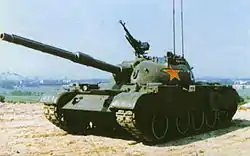
Over the years, the Type 59 design was enhanced with various domestically developed and western technologies; When the PLA captured a Soviet T-62 during the Sino-Soviet border conflict in 1969, improvements based on the T-62 were incorporated into the Type 59 design to become the Type 69 MBT. The Type 69 was further upgraded with Western technology and became the Type 79 MBT. The Type 59 was therefore, the first in China's first generation of main battle tanks, the Type 79 being the last. The Type 79 was superseded by the Type 80 second-generation MBT.
The Type 59 MBT is also known as WZ-120 by its manufacturer. Over 10,000 were produced between 1959 and mid 1980s.[1] This tank gained worldwide infamy after the "Tank Man" incident in 1989. The Type 59, and its successor, the Type 69, were widely exported, with thousands sold overseas. Today an estimated 5,000 Type 59 MBTs remain in PLA inventory, but its being supplanted by the more capable Type 96 and Type 99 MBTs.
Combat service
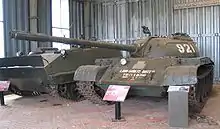
The first war involving the Type 59 was in Vietnam, where North Vietnam fielded at least hundreds supplied directly from their Chinese ally against American tanks used by their South Vietnamese enemy, such as the M41 Walker Bulldog light tank and the M48 Patton main battle tank. Against the US tanks in faced in Vietnam, the Type 59, along with the similar T-54 tank of Soviet origin (also widely operated in the war by North Vietnam), achieved at least minimal success, if not considerable, against enemy armour. Most of the losses of armour suffered by the US and South Vietnamese forces were to North Vietnamese infantry-based anti-tank weapons, such as the RPG-7, rather than to North Vietnam's own tanks and other armour.
The Pakistani Type 59s were also fielded during the Indo-Pakistani War of 1971.[4]
Following the Vietnam War, the Sino-Vietnamese War of 1979 was the next largest use of Type 59 tanks to date in modern Chinese military history. China committed nearly 300 Type 59, Type 62, and Type 63 tanks and armoured fighting vehicles (AFVs) into the conflict against their former ally, with 48 of the total listed above lost to Vietnamese anti-tank action. The tanks of 42nd Corps, as the vanguard force responsible for cutting off the northern Vietnamese city of Cao Bằng, bore the brunt of the losses in armour and managed to advance only 30 km within 3 days. The poor performance of tanks and AFVs in this battle was attributed to the mountainous and hilly terrain in much of northern Vietnam that was inherently unsuitable for mechanized warfare, just like in Korea. The light armour on the Type 62 tank (a lighter version of the Type 59 which predominantly served as a combat-reconnaissance vehicle) also proved inadequate in protection against small and light anti-tank weapons, such as anti-tank grenades.
Iran received 300 Type 59 tanks from North Korea and China during the Iran–Iraq War.[5] They were fielded by both the regular Artesh and the Islamic Revolutionary Guard Corps.[6] The T-72 proved highly superior to the Chinese tank.[7] On the other hand, Iraq received 1,000 Type 59s from China.[8] The Iraqi Type 59 tanks were later used during the 1991 Gulf War.[9]
The Sudan also used Type 59 tanks during the Sudanese Civil War. Five were lost to the Sudan People's Liberation Army near Yei in March 1997.[10]
The Type 59s of the Zairian Special Presidential Division saw limited action in 1998 against the rebels of the Alliance of Democratic Forces for the Liberation of Congo.[11]
Variants
Domestic models
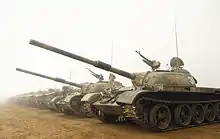

- Type 59
- The basic variant, a T-54A clone without an IR searchlight. Entered production in 1957.
- Type 59-I
- Improved variant fitted with a Type 69-II 100 mm rifled gun, as well as a laser rangefinder, hydraulic servo-system, primitive fire-control system, automatic fire suppression system, and rubber track skirts. The Type 59-I includes several versions with different armour and fire control configurations.
- Type 59-II
- The Type 59-II (also known as WZ-120B) is an upgrade mounting a 105 mm rifled gun, similar to the Royal Ordnance L7, and adding an image intensification/infrared night sight. Mass increased to 36.5 tonnes.[12]
- Type 59-IIA
- Although the Type 59-II was a very successful design, the tank still relied on the West to supply parts. As a result, the Type 59-IIA was developed. By the end of 1984, the China First Tractor Factory and other production facilities began to develop a further upgrade to the Type 59-II. A prototype was completed by October 1985, featuring an improved 105mm Type 83 gun, a copied version of the Royal Ordnance L7, with a thermal sleeve, new domestic light spot fire control system with a 2-axis stabilizer, and composite armor. The automatic fire suppression system and automatic fire extinguishing devices were improved so that they could be used while generating smoke or firing the onboard smoke grenade launchers.[13]
- Type 59D1
- The Type 59D1 (also known as WZ-120C) is an upgrade with explosive reactive armour, computerized stabilized fire-control system, the 105 mm gun of the Type 59-II, and a night vision system.[14]
- Type 59D
- Type 59D (also known as WZ-120D) is an upgrade of the Type 59D1. The Type 59D has a longer 105 mm gun, known as the Type 83A, or Type 94. The gun has a range of 2000 m, and may fire ATGMs out to 5500 m. A thermal sight is also available.[14]
- Type 59G
An upgrade of the Type 59, featuring a redesigned turret and armor. It uses a turret similar to that of the Type 96A, a 125 mm gun, modern fire control systems, arrow-shaped armor, spaced armor, and possibly third-generation subsystems.[15][16][17]
- Jaguar
The Jaguar was a prototype vehicle based on the Type 59 chassis that was jointly developed by the United States and China during 1980s, made possible by the US-Chinese détente of the 1970s. Planned to replace China's existing tank fleet, as well as for the export market, the tank featured improvements to the standard Type 59's engine, armament, armour, turret, optics, electronics, fire control and suspension. Following the Tiananmen Square protests of 1989, American-Chinese relations soured and the Chinese withdrew from the project. The Americans continued alone and successfully completed the design, however the end of the Cold War saw a glut in the international tank market and thus no orders were ever placed for the vehicle.[18][19]
- Type 62 Light Tank
In the late 1950s, the PLA submitted requirements for a light tank more suitable for operations in China's southern region. Development on the new Type 62 tank began in 1958, which was a scaled-down Type 59 MBT with simplified equipment. The Type 62 light tank entered batch production in 1963, and approx. 800 were produced by 1978. The Type 62 light tank weights only 21 tons, and is equipped with a Type 62-85TC 85 mm rifled gun, and 3 machine guns. An improved Type 62-I version was produced with better FCS with laser rangefinder, and turret storage racks for added protection. Other versions based on the Type 62 include the Type 79 recovery vehicle (prototype only) and Type 82 earth-mover.
The PLA deployed the Type 62 light tank to Vietnam during the 1979 Sino-Vietnam conflict. They found that the thin armor of the Type 62 tank could be penetrated easily by hand-held anti-tank weapons, such as the 40 mm RPG. The Type 62 tank suffered severe losses during the conflict, which convinced the PLA to develop new second-generation MBTs. The Type 62 tank received a major upgrade in 2000, with new welded turret, vertically stabilized 105 mm rifled gun, fire-control system, night vision device, smoke grenade launchers, and explosive reactive armor (ERA) package.[20]
- Type 69 / 79
Improved Type 59 MBT built by 617 Factory (Inner Mongolia First Machine Group Co. Ltd). Only saw limited service in the PLA, but was an export success in the 1980s with more than 2,000 sold worldwide.
- Type 73
This armored recovery vehicle is a Type 59 with its turret removed. The vehicle is armed with a single 12.7 mm machine gun. This armored recovery vehicle is not believed to have a winch and is limited to towing operations.[3]
- Type 59 Heavy Infantry Fighting Vehicle
The modernized HIFV model of Type 59 weighs around 40 tons and can carry up to seven passengers. Modifications include moving the engine to the front of the vehicle chassis, increasing tank armor including explosive reactive armor on all sides, and installing a rear door for dismounting infantry.[21]
- QN-506
It is a modernized variant of the Type 59 using the tank's chassis similar to its Russian counterpart the BMPT Terminator. The vehicle was first appeared at the Zhuhai Air Show in China in November 2018, and is armed with two QN-502C anti-tank missiles, ten QN-201 multi-purpose mini missiles, four S-507 loitering munitions, an unmanned 30 mm cannon, a 7.62 mm machine gun, six grenade launchers, and a quadcopter surveillance drone.[22][23]
Foreign variants
United Kingdom designed a variant with 105-mm L7 gun as an upgrade package for owners of the Type 59. No Type 59s served with British forces.[3] Marconi offered their Marksman anti-aircraft system as a conversion to operators of the Type 59. The Marksman consisted of a twin 35 mm autocannon system in a turret that could be fitted to almost any MBT.[3]
Iran operates Type T-72Z based on Type 59.
North Korea operates Kok'san – 170 mm artillery piece, based on the Type 59 chassis.
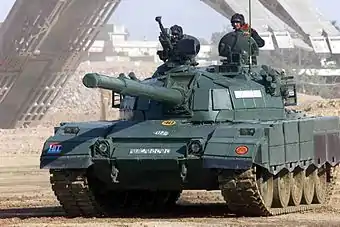
Pakistan operates Al-Zarrar – Heavy Industries Taxila of Pakistan has introduced the Al-Zarrar Main Battle Tank. The Al-Zarrar series was designed to improve and rebuild the Pakistani army's Type 59 tanks by way of more modern armament, fire control, defensive equipment, etc. Improvements include:
- 125 mm smoothbore gun, firing APFSDS, HEAT-FS and HE-FS. Semi-automatic loading and image Stabilized fire control.
- 730 hp Engine for improved mobility.
- Improved suspension.
- Improved defense with explosive reactive armour and anti-mine cover underneath.
.jpg.webp)
Bangladesh Army's Type-59 are being upgraded to Type 59G(BD) Durjoy locally with Chinese assistance. 174 are being upgraded in First batch. Upgradation process includes:
- 125mm main gun with new turret (similar to that of the Type 96A turret) 28 rounds, Type-85 12.7×108mm Commander's machine gun (3,000 rounds), Co-axial 7.62mm gun (600 rounds), 81mm Smoke grenades.
- The Durjoy's APFSDS round can penetrate over 500mm of RHA at 2 km[24]
- Chinese 3rd generation ERA on front, turret and side skirts. Modular Composite armour on turret front. Cage armour on back of turret to protect from RPG hits.
- To enhance crew comfort the Durjoy is fitted with air-conditioning and complete NBC protection system
- Collective Fire suppression system.
- Laser warning receiver, Laser designator, Fire control system, Combat data link, Thermal imaging system.
- 730 H.P. Diesel engine
- Barrel launched ATGM firing capability.
- Rubber padded tracks.[25]
- XDZ-1 SATCOM and VRC-2000L radio contact system.[24]
Operators

.jpg.webp)
Current operators
- 30 T-54 delivered by Egypt in 1975;[17] later converted to use Type 59 parts with support from China.[2] 36 Type 59s delivered by China in 1980–1981.[17]
- 780 Type 59s and Type 69s in service in 2004 and 2006.[26][27] According to IISS, 174 Type 59s in service in 2010;[28] 174 Type 59s in 2014.[29]
- 36 battalions of Type 59/Type 59-1 (1,300 units), 16 battalions of Type 59-2 (510 units), 17 battalions of Type 59D (550 units), in total 2,360 units in service in December 2015.[32]
![]() Democratic Republic of the Congo
Democratic Republic of the Congo
- ~300 Type 59s delivered by China from 1982–1984, and ~500 Type 69-IIs from 1986-1988 (possibly through North Korea.)[17]
- 540 T-54/T-55/Type 59s in service in 2004 through 2010,[26][27][37] with that number including Safir 74 conversions by 2014.[38]
- 250-1300 Type 59s delivered by China from 1982–1987, and ~1500 Type 69-I and 69-IIs delivered from 1983–1987.[17]
- ~3000 T-54, T-55, Type 59 and Type 69s before the Gulf War.[39] 1000 T-54, T-55, T-72, Type 59 and Type 69s in service in 2003.[40]
- 160 of Type-59D in service.[41]
- ~175 Type 59s delivered by China from 1973–1975. ~250 ZSU-57-2 turrets delivered by the Soviet Union in 1968–1977 and fitted to Type 59 hulls from China.[17] 175 Type 59s in 1985 and 1990 and 500 in 2000;[2][42] ~3,500 T-34s, T-54s, T-55s, T-62s and Type 59s in 2004;[26] and more than 3,500 in 2006 through 2014.[27][43]
- ~200 Type 59s delivered by China from 1965–1966; ~550 Type 59s delivered from 1967–1970; ~100 Type 59s delivered as aid in 1972; ~825 delivered from 1978 to 1988.[17] 1100 Type 59s in service in 2010;[44] 1100 Type 59/Al-Zarrars in service in 2018.[45]
- ~50 Type 59s delivered by China in 1972; according to SIPRI, ~40 of those rebuild in Sudan as Type 59Ds from 2010–2014.[17] According to IISS, 60 Type 59 and Type 59Ds in service in 2010 and 2014.[46][47]
- ~30 Type 59s delivered by China from 1971–1973; according to SIPRI, these were rebuilt as Type 59Gs from 2011–2013.[17] According to IISS, 15 Type 59s in service in 2010,[48] and 15 Type 59Gs in service in 2014.[49]
Former Operators
- ~721 Type 59 delivered by China in 1966–1975. None in service currently
- ~25 Type 59 delivered by China in 1991.[17] None in service by 2010.[56]
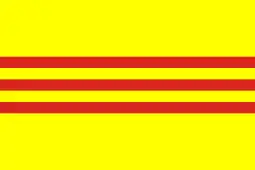 South Vietnam:Captured from People's Army of Vietnam
South Vietnam:Captured from People's Army of Vietnam
See also
- Type 69/79
- Type 80/85/88
- Type 96
- Type 90/MBT-2000
- Type 99
- T-54
References
- Gelbart, Marsh (1996). Tanks main battle and light tanks. Brassey’s UK Ltd. pp. 16–17. ISBN 1-85753-168-X.
- Christopher F Foss. Jane's Armour and Artillery 2005-2006.
- "Gary's Combat Vehicle Reference Guide". Archived from the original on 4 January 2008. Retrieved 6 January 2008.
- Dunstan, Simon (10 November 2009). Centurion vs T-55: Yom Kippur War 1973. Duel 21. Osprey. p. 33. ISBN 9781846033698.
- Razoux, Pierre (2015). The Iran- Iraq war. Translated by Elliott, Nicholas. Cambridge, Massachusetts and London, England: Harvard University Press. p. 536. ISBN 978-0-674-08863-4.
- Razoux 2015, pp. 270, 555.
- Razoux 2015, pp. 245, 394.
- Razoux 2015, p. 530.
- Dutrône, Christophe (February 2011). "Guerre du Golfe, 1990-1991 : La bataille des cents heures". Batailles & Blindés (in French). No. 41. Caraktère. pp. 60–75&84. ISSN 1765-0828.
- Connell, Dan (August 1998). "Armed forces and armaments". Global trade, local impact: Arms Transfers to all Sides in the Civil War in Sudan. Volume 10 number 4. Human Rights Watch.
- Jean-Jacques Wondo Omanyundu (19 November 2014). "Portrait : Qui est Ilunga Kampete, le nouveau commandant de la Garde républicaine ?". desc-wondo.org (in French). Archived from the original on 6 October 2018. Retrieved 8 October 2018.
- Ground Systems. Worldwide Equipment Guide. 1 (2011 ed.). US Army TRADOC Intelligence Support Activity. pp. 5–39, 5–41, 5–42. Retrieved 16 July 2015.
- "Type 59 variants". Archived from the original on 21 September 2019. Retrieved 22 September 2019.
- Ground Systems. Worldwide Equipment Guide. 1 (2011 ed.). US Army TRADOC Intelligence Support Activity. pp. 5-41–5-42. Retrieved 16 July 2015.
- "Archived copy". Archived from the original on 17 April 2017. Retrieved 16 January 2016.CS1 maint: archived copy as title (link)
- "Archived copy". Archived from the original on 24 September 2016. Retrieved 16 January 2016.CS1 maint: archived copy as title (link)
- "Arms Transfers Database". Stockholm International Peace Research Institute. Archived from the original on 14 April 2010.
- Military Today, "Jaguar" Archived 26 May 2018 at the Wayback Machine
- Forecast International, "Jaguar - Archieved 4/98" Archived 18 May 2018 at the Wayback Machine, Archived Reports, April 1997
- "Type 62 Light Tank". SinoDefence.com. 20 February 2009. Archived from the original on 12 March 2010. Retrieved 21 March 2010.
- "For sale: China's lineup of brand new, souped-up tanks". Popular Science. Archived from the original on 20 September 2017.
- "Archived copy". Archived from the original on 17 November 2018. Retrieved 17 November 2018.CS1 maint: archived copy as title (link)
- "Archived copy". Archived from the original on 17 November 2018. Retrieved 17 November 2018.CS1 maint: archived copy as title (link)
- Syed Amar Khan (30 August 2019). "Bangladesh Army tests indigenously upgraded Durjoy tanks". Bangladesh. Archived from the original on 13 October 2019. Retrieved 2 September 2019.
- "Archived copy". Archived from the original on 19 August 2017. Retrieved 19 August 2017.CS1 maint: archived copy as title (link)
- Military Balance 2004–2005
- Military balance 2006-2007
- International Institute for Strategic Studies: The Military Balance 2010, p.358
- International Institute for Strategic Studies: The Military Balance 2014, p.227
- International Institute for Strategic Studies: The Military Balance 2010, p.398
- International Institute for Strategic Studies: The Military Balance 2014, p.230
- "中国陆军还剩下多少"五对轮"的59坦克_新闻_腾讯网". news.qq.com. Archived from the original on 21 January 2016. Retrieved 17 January 2016.
- International Institute for Strategic Studies: The Military Balance 2010, p.303
- International Institute for Strategic Studies: The Military Balance 2014, p.432
- International Institute for Strategic Studies: The Military Balance 2010, p.301
- International Institute for Strategic Studies: The Military Balance 2014, p.429
- International Institute for Strategic Studies: The Military Balance 2010, p.251
- International Institute for Strategic Studies: The Military Balance 2014, p.319
- Cordesman: p. 4
- Cordesman: p. 63
- Enclopedia, Tank. "Type-59 main battle tank". Archived from the original on 20 October 2020.
- "Global Security.org North Korea". Archived from the original on 23 November 2014. Retrieved 26 October 2010.
- International Institute for Strategic Studies: The Military Balance 2014, p.412
- International Institute for Strategic Studies: The Military Balance 2010, p.368
- International Institute for Strategic Studies: The Military Balance 2019, p.297
- International Institute for Strategic Studies: The Military Balance 2010, p.327
- International Institute for Strategic Studies: The Military Balance 2014, p.461
- International Institute for Strategic Studies: The Military Balance 2010, p.329
- International Institute for Strategic Studies: The Military Balance 2014, p.463
- International Institute for Strategic Studies: The Military Balance 2010, p.433
- International Institute for Strategic Studies: The Military Balance 2014, p.287
- International Institute for Strategic Studies: The Military Balance 2010, p.331
- International Institute for Strategic Studies: The Military Balance 2014, p.467
- International Institute for Strategic Studies: The Military Balance 2010, p.332
- International Institute for Strategic Studies: The Military Balance 2014, p.468
- International Institute for Strategic Studies: The Military Balance 2010, p.370
- Bibliography
- Cordesman, Anthony H. (7 February 2003). Iraqi Armed Forces on the Edge of War (PDF) (Report). Center for Strategic and International Studies. p. 26. Retrieved 16 July 2015.
- Gelbart, Marsh (1996). Tanks: Main Battle and Light Tanks. London: Brassey's. ISBN 1-85753-168-X.
- International Institute for Strategic Studies (2010). Hacket, James (ed.). The Military Balance 2010. Oxfordshire: Routledge. ISBN 978-1-85743-557-3.
- International Institute for Strategic Studies (2014). Hacket, James (ed.). The Military Balance 2014. Oxfordshire: Routledge. ISBN 978-1-85743-722-5.
External links
| Wikimedia Commons has media related to Type 59. |
- Type 59 Main Battle Tank - GlobalSecurity.org
- Type 59 Main Battle Tank - FAS
- Type 59 Main Battle Tank - CDI
